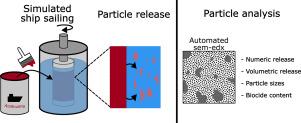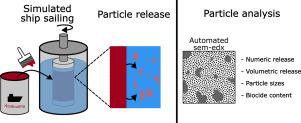Characterization of microplastics from antifouling coatings released under controlled conditions with an automated SEM-EDX particle analysis method
IF 7.3
2区 环境科学与生态学
Q1 ENVIRONMENTAL SCIENCES
引用次数: 0
Abstract
A significant portion of microplastics in the marine environment originate from antifouling coatings. However, knowledge about release pathways and rates is limited. One such pathway is particle release from ship hull coatings during sailing. This study demonstrates the release of microplastic particles from a typical commercial antifouling coating in simulated low-speed sailing conditions. The self-polishing antifouling yacht coating was exposed to controlled low-speed sailing conditions in artificial seawater. The particle content of the artificial seawater was monitored throughout an automated particle analysis protocol using scanning electron microscopy and energy dispersive X-ray spectroscopy (SEM-EDX). Particle counts, sizes and chemistries were recorded. Over the duration of the exposure, the total particle volume release increased with time. Particle release behaviour can be correlated to the polishing behaviour of antifouling coatings. The equivalent diameter of the majority of the particles was 1–5 m. The particles were mainly composed of carbon (around 58%wt.), oxygen (around 32%wt.), copper (0–8%wt.), and zinc (0–2%wt.). Carbon and part of the oxygen can be ascribed to the polymeric binder in the coating. Copper and zinc, on the other hand, can be attributed to the known biocidal pigments in the coating. This study improves our understanding of particle release from antifouling coatings.


用自动SEM-EDX粒子分析方法表征受控条件下防污涂料释放的微塑料
海洋环境中的微塑料很大一部分来自防污涂层。然而,关于释放途径和速率的知识是有限的。其中一种途径是在航行过程中从船体涂层中释放颗粒。本研究演示了典型商用防污涂料在模拟低速航行条件下的微塑料颗粒释放。对游艇自抛光防污涂料进行了人工海水控制低速航行试验。通过扫描电子显微镜和能量色散x射线能谱(SEM-EDX)自动颗粒分析方案监测人工海水的颗粒含量。记录颗粒计数、大小和化学成分。在暴露的持续时间内,总颗粒体积释放随时间而增加。颗粒释放行为可以与防污涂层的抛光行为相关联。大部分颗粒的等效直径为1 ~ 5 μμm。这些颗粒主要由碳(约58%重量)、氧(约32%重量)、铜(0 - 8%重量)和锌(0 - 2%重量)组成。碳和部分氧可归因于涂层中的聚合粘合剂。另一方面,铜和锌可以归因于涂层中已知的生物杀灭色素。这项研究提高了我们对防污涂料颗粒释放的认识。
本文章由计算机程序翻译,如有差异,请以英文原文为准。
求助全文
约1分钟内获得全文
求助全文
来源期刊

Environmental Pollution
环境科学-环境科学
CiteScore
16.00
自引率
6.70%
发文量
2082
审稿时长
2.9 months
期刊介绍:
Environmental Pollution is an international peer-reviewed journal that publishes high-quality research papers and review articles covering all aspects of environmental pollution and its impacts on ecosystems and human health.
Subject areas include, but are not limited to:
• Sources and occurrences of pollutants that are clearly defined and measured in environmental compartments, food and food-related items, and human bodies;
• Interlinks between contaminant exposure and biological, ecological, and human health effects, including those of climate change;
• Contaminants of emerging concerns (including but not limited to antibiotic resistant microorganisms or genes, microplastics/nanoplastics, electronic wastes, light, and noise) and/or their biological, ecological, or human health effects;
• Laboratory and field studies on the remediation/mitigation of environmental pollution via new techniques and with clear links to biological, ecological, or human health effects;
• Modeling of pollution processes, patterns, or trends that is of clear environmental and/or human health interest;
• New techniques that measure and examine environmental occurrences, transport, behavior, and effects of pollutants within the environment or the laboratory, provided that they can be clearly used to address problems within regional or global environmental compartments.
 求助内容:
求助内容: 应助结果提醒方式:
应助结果提醒方式:


